Lallart M. (ed.) Ferroelectrics - Physical Effects
Подождите немного. Документ загружается.


Ferroelectric Liquid Crystals with High Spontaneous Polarization
409
Fig. 1. The helicoidal structure of chiral smectic C (SmC*) liquid crystal. The molecular
dipole moment p
i
is always perpendicular to the director n and tangential to the circle of
intersection of the cone with the boundary plane of the layer. Azimuthal angle
φ
is a
function of the coordinate z parallel to the layer normal,
θ
is the tilt angle.
chirality there is a non-zero in-layer spontaneous dipole moment which is perpendicular to
the average molecular direction (director n) and to the tilt direction. To understand the
origin of the layer dipole moment one has to consider that in contrast to the non-chiral
molecules, the chiral ones do not rotate freely along their long axes. The chiral centre
represents a steric hindrance for the molecular rotation, which results in a non compensated
part of the transversal molecular dipole moment p
i
. Due to random head-tail alignment of
molecules only an in-layer component of the dipole moment remains, and create the layer
dipole moment P.
The other aspect of chirality is rotation of the director and thus also of the direction of dipole
moment P about the smectic layer normal (see Fig. 1). The helix can be either right-handed
or left-handed depending on the chirality of constituent molecules. Due to formation of the
helical superstructure the spontaneous polarization is compensated to zero within one pitch
of the helix, p, and the material appears to be non-polarized. Thus, strictly speaking, the
SmC
∗
phase is not ferroelectric, but use to be regarded as helielectric.
Z
Molecular dipole
moment, p
i
Pitch, p
Layer
spacing
2
θ
Molecular
director n
φ
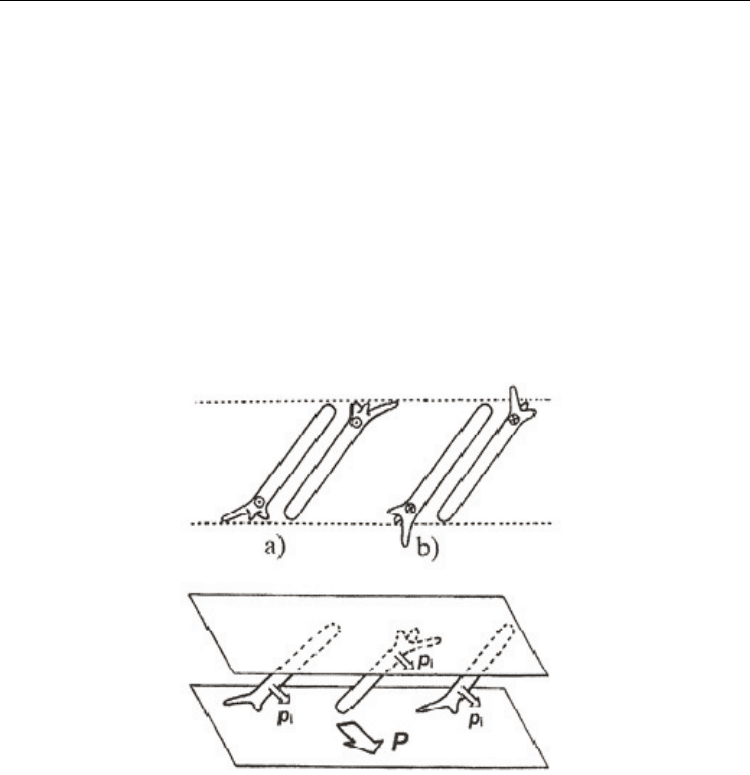
Ferroelectrics – Physical Effects
410
Under an external electric field the local polarization P is aligned to the field direction thus
unwinding the helical structure. In an alternating (a.c.) electric field a typical ferroelectric
switching current, as well as electrooptical response is observed. This effect, being relatively
fast (~10 μs), represents the main principle of technical applications.
From the switching current the value of the macroscopic spontaneous polarization, P
s
, of the
material can be evaluated.
To understand the origin of the layer dipole moment P several models have been suggested.
In very simple one (Beresnev & Blinov, 1981), the molecules are considered as being tilted
within layers and randomly distributed head to tail (Fig. 2). The chiral centre is depicted as
an uneven tripod with unequally long arms. From steric reason the molecules prefer to tilt
in the direction shown in Fig. 2a rather than in Fig. 2b and all the transverse molecular
dipoles lie preferentially in one direction, orthogonal to the tilt direction. In reality, the
molecules are spinning rapidly, and this preferred tilt direction then becomes a more
energetically favored position due to steric hindrance if an mirror symmetry is absent in
the layer.
Fig. 2. Schematic arrangement of chiral molecules in the SmC* phase, p
i
being the molecular
dipole moment. Due to chiral group, depicted by the tripod, the molecules prefer (a) rather
than (b) and thus all the molecular dipole moments lie in the direction as shown in lower
part of the figure as P.
For application of FLCs in electrooptical displays, the helicoidal structure must be
suppressed otherwise an optically homogeneous field cannot be reached. It is achieved in so
called Surface Stabilized Ferroelectric Liquid Crystal (SSFLC) being only about 1 μm thick
(Clark & Lagerwall, 1983).
It is necessary to accent that in many FLCs the value of P
s
is considerably temperature
dependent. With increasing temperature P
s
decreases and disappears at the transition to the
high temperature SmA phase, chiral nematic phase (N*) or isotropic liquid at specific
temperature T
c
. Typical behavior of such temperature dependence is seen in Fig. 3.
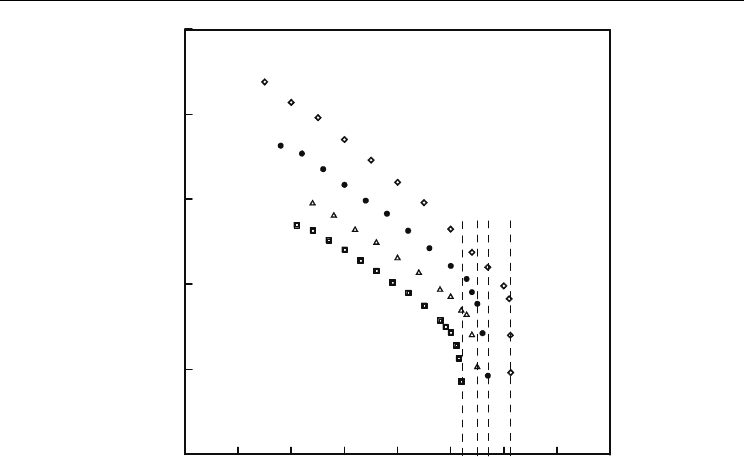
Ferroelectric Liquid Crystals with High Spontaneous Polarization
411
Fig. 3. Temperature dependence of the spontaneous polarization for series of compounds
XV for X = F; n, m are numbers of carbon atoms in aliphatic chains (see Tab. 8), T
c
is a
temperature at which the SmC* phase transforms to a phase without spontaneous
polarization.
In addition, temperature range of the SmC* phase strongly differs for various substances.
Therefore, for comparison of the spontaneous polarization of different compounds values of
P
s
at a definite temperature T below T
c
use to be given (usually for T
c
–T = 5, 10 or 20 K). But
still comparison of the spontaneous polarization for different substances at the same
temperature is solitary.
Let us point out that both FE and AF dipolar order exists also in tilted chiral smectic phases,
in which (in contrast to the SmC* phase) the smectic layers exhibit a hexatic molecular
arrangement due to a strong bond orientational order, or in so called low temperature chiral
tilted smectics with a hexagonal or square molecular arrangement within the smectic layers
and long range correlations in the direction of the smectic layer normal. These types of
phases are not suitable for application as the polarization switching as well as the
electrooptic response is significantly slower or are not switchable at all.
3. Relation of the molecular structure and the SmC
∗
phase formation
Basic requirements on molecules to be able to create the SmC* mesophase can be described
as follows:
1. Rod-like shape and ability to form a layered mesophase where the long axes of
constituent molecules are tilted with respect to the layer planes. In more detail see e.g.
(Goodby et al., 1991).
8/7
8/10
8/5
8/12
70 80 90 100 11 120 130 140 150
0
50
100
150
200
250
n
/
m
T
c
TEMPERATURE, °C
SPONTANEOUS POLARIZATION
(nC cm
-2
)

Ferroelectrics – Physical Effects
412
2. Chirality (either right- or left-handed), ensured by the presence of at least one
asymmetric carbon, located usually on one or on both ends of molecules. Location of
the asymmetric carbon in the central part of molecule is very rare (Barbera et al.,
1989).
3. The existence of a transversal dipole moment borne by a functional group e.g. -C=O, -
CN, -Cl, etc. This dipole moment is not averaged to zero by the molecular rotation
because of hindering by the chiral centre. As for the intramolecular motion, rotation
between the polar and chiral groups is not free.
In the following discussion we limit oneself to substances containing asymmetrical carbon
only in one side of molecule, since possibilities of practical use of materials with
asymmetrical carbon on both ends and/or in the central core of a molecule are scarce. Only
a few such substances are known to establish generally valid relations.
For the following consideration, it is advantageous to divide a typical rod-like FLC molecule
to several parts:
R – A – X – A – Y – A – Z – R*
a. Central linear rigid core is formed as a rule by two or three aromatic or heteroaromatic
rings denoted as A, which are connected by linkage groups X and Y. As a rule X and Y
represent a simple bond, e.g. -COO-, -CH=N-, -N=N- etc.
b. Non-chiral terminal chain R (as a rule an unbranched alkyl- or alkyloxy group).
c. Chiral terminal chain R* with one or more asymmetric carbons C*, most frequently it is
-C*H(CH
3
)-(CH
2
)
m
CH
3
, m = 1 to 5.
d. Linkage group Z between the core and the terminal chains formed either by a single
bond or combination of more groups, some of them bringing the molecule transverse
dipole moment (e.g . -CH
2
-, -CH=CH-, -COO-, -CO-).
Presently, number of substances composed of rod-like molecules and forming the
ferroelectric mesophase amounts to thousands. Unfortunately, in many of them the values
of P
s
at temperatures relevant for comparison are not available. Therefore, evaluation of
factors influencing P
s
is rather difficult. The most promising ways for P
s
increase are
discussed below.
4. Ways of spontaneous polarization enhancement
For the value of the spontaneous polarization P
s
the existence of the lateral molecular dipole
moments p
i
is essential and increasing of p
i
seems to be the first natural way for P
s
increasing. One has to realize that the P
s
value is not just a result of a simple addition of p
i
values in the volume. Rotation of LC molecules around their long axes and various
intramolecular rotations lower this value significantly. Therefore, restriction of these
rotations is further and very important way to P
s
enhancement. Both ways closely relate to
configuration of the chiral centre in the molecule, to number of asymmetric carbons in the
molecule and are connected with nature of the bond between the chiral part and central
linear rigid core. Therefore, still new substituents have been examined (see Table 1), which
finally resulted in preparation of compounds with very high spontaneous polarization up to
the order of 10
2
nC cm
-2
.
In all Tables hereafter substituents C
m
H
2m+1
and C
n
H
2n+1
are linear. Aromatic rings are
bonded in positions 1,4.

Ferroelectric Liquid Crystals with High Spontaneous Polarization
413
Table 1. Examples of chiral substituents.
4.1 Restriction of molecular rotations
Molecular dipole moment p
i
rotates together with LC molecule as a whole around its long
axis but this rotation is hindered because of various restrictions. It means that both
molecular short (lateral) axis and molecular dipole moment are directed in preferred
orientation for longer time. The uncompensated molecular dipole moment is an origin of the
spontaneous polarization within the SmC* layer.
Degree of molecular alignment with respect to the director can be described by an
(orientational) order parameter S
k
1
,
which has very low value for orientation of the short
axis. Measurable values of the spontaneous polarization are expected for S
k
> 10
-3
. The larger
S
k
the higher probability of lateral molecular axes to be directed in preferred direction and
the larger contribution of p
i
to P
s
.
Steric hindrances participate in a restriction of molecular rotations very effectively. In this
respect the chiral centre, depicted as an uneven tripod with unequally long arms (see Fig. 2),
plays an important role. With increasing asymmetry of the tripod its restrictive effect as well
as S
k
increases. This effect has been observed for numerous compounds (Chin et al., 1988;
Nakauchi et al., 1989; Sakurai et al., 1984; Yoshizawa et al., 1989), some examples of
compounds with the chiral centre –C
∗
H(CH
3
)-C
m
H
2m+1
are shown in Table 2. Of course, the
increase of P
s
in this way is limited. An optimal length of the aliphatic chain exists for which
P
s
has a maximal value and additional lengthening leads to the spontaneous polarization
decrease (see Table 2).
On the other hand branching of a terminal substituent and lengthening of aliphatic chains
suppresses in many cases thermal stability of the mesophase narrowing the temperature
1
Orientational order parameter, S
k,
characterizes degree of molecular alignment with respect to the
director. It takes the values between zero and one. For a completely random and isotropic sample, S=0,
whereas for a perfectly aligned sample S=1.
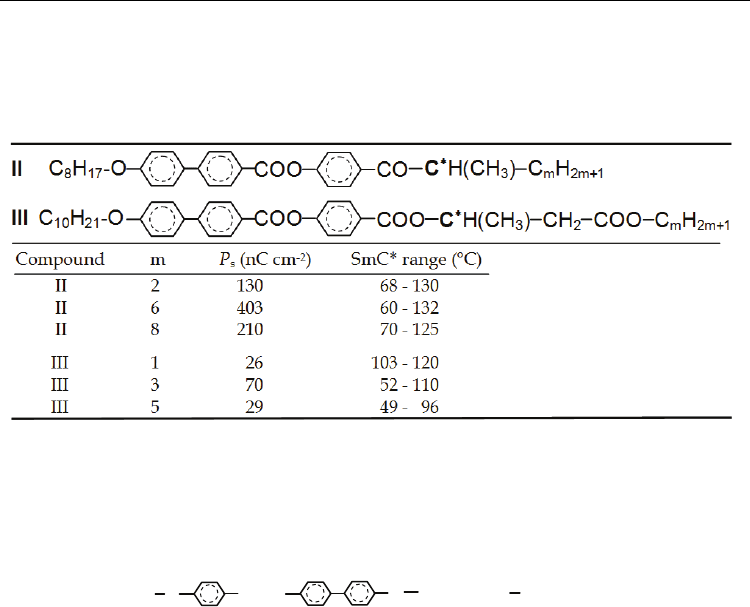
Ferroelectrics – Physical Effects
414
range of the mesophase or fully prevents its formation. This negative effect can be
compensated by elongation of the central linear rigid core of the molecule. Therefore, the
most of ferroelectric liquid crystals with strongly asymmetric chiral center R* (m=6) has
three aromatic or heteroaromatic rings in the central core.
Table 2. Temperature range of the SmC* mesophase and maximum values of the
spontaneous polarization P
s
for compounds II (Yoshizawa et al., 1989) and III (Nakauchi et
al., 1989). Influence of the chiral centre asymmetry.
Combination of mentioned chiral centre
with tricyclic rigid molecular core of the ester type
provided first chemically stable substances
n = 5-12,
with rather high spontaneous polarization (P
s
~ 50 nC cm
-2
) (Inukai et al., 1986). First
commercial ferroelectric mixtures (Japan CHISSO Corp.) designed for electro-optical
applications working in a broad temperature range around room temperature were based
on the mentioned compounds. Similarly, the first Czech experimental memory electro-
optical cells with surface stabilized ferroelectric liquid crystal (SSFLC) were realized with
this material already in the year 1987 (Pirkl, 1990).
It is hardly possible to assess unambiguously the effect of others factors on molecule
rotation either for lack of data, or because of combination of impacts (e.g. a side substituent
on the central core in addition to the steric constraint brings also a significant transverse
dipole moment).
4.2 Restriction of intramolecular rotations
Strength of the spontaneous polarization can be increased considerably by restricting the
freedom of the chiral center rotation in relation to the molecule as a whole. Many single
bonds in FLC molecules enable more or less independent rotation of particular parts of the
molecule around its long axis. This is regarded as the second main reason of a low
contribution of molecules to resulting dipole moment of the smectic layer. The lowering is
particularly strong if the dominant transversal molecular dipole moment rotates
independently of the chiral group.
C
n
H
2n+1
O
OCO
O
C
∗
H
(
CH
3
)
C
6
H
13
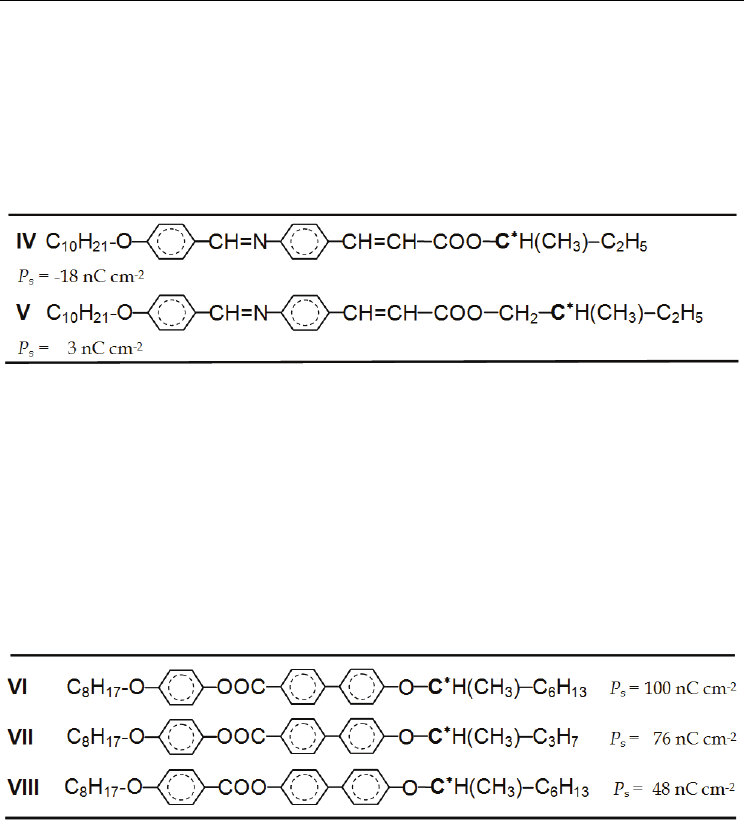
Ferroelectric Liquid Crystals with High Spontaneous Polarization
415
Generally, shortening the distance and lowering the amount of longitudinal bonds between
the position of the molecular transverse dipole moment and asymmetric carbon is regarded
as a way for suppressing the negative influence of intramolecular rotations. The most radical
way would be to introduce the dipole moment directly to the chiral group, as will be
discussed below.
Definitely, the methyl group located at the linkage position Z lowers the P
s
value
significantly (see Table 3).
Table 3. Maximum values of the spontaneous polarization P
s
for compounds IV (Sakurai et
al., 1984) and V (Uemoto et al., 1981). Influence of a bridge group Z (−CH
2
)−.
The effect of various molecular constituents should not be considered separately, as the
complex molecular configuration plays a role. For example, the characteristic free rotation of
both rings about the central linkage of biphenyl group can be restricted by suitable
neighboring groups, which increases the order of the chemical bond due to mesomeric
effect. The result of this conception is documented in Table 4. In compound VI one can
suppose that mesomeric as well as induction effect increase the dipole moment of the central
carbonyl group and together with strongly asymmetric chiral centre bring about the increase
of the P
s
value.
Table 4. Values of the spontaneous polarization P
s
at temperatures T
c
– 20 °C below the
SmC*- SmA transition (Inukai et al., 1986). Influence of the mesomeric effect.
4.3 Enhancement of transversal molecular dipole moment
Enhancement of the transversal molecular dipole moment represents one of the effective
ways for the increase of the P
s
value, the location of this dipole moment as well as the
volume of the lateral substituent being important. In the absolute majority of FLC one of the
functional group built in the central skeleton or in the linkage group Z is the source of the
transversal dipole moment. Frequently it is the carbonyl group >C=O, the dipole moment of
which can be increased due to mesomeric effect.
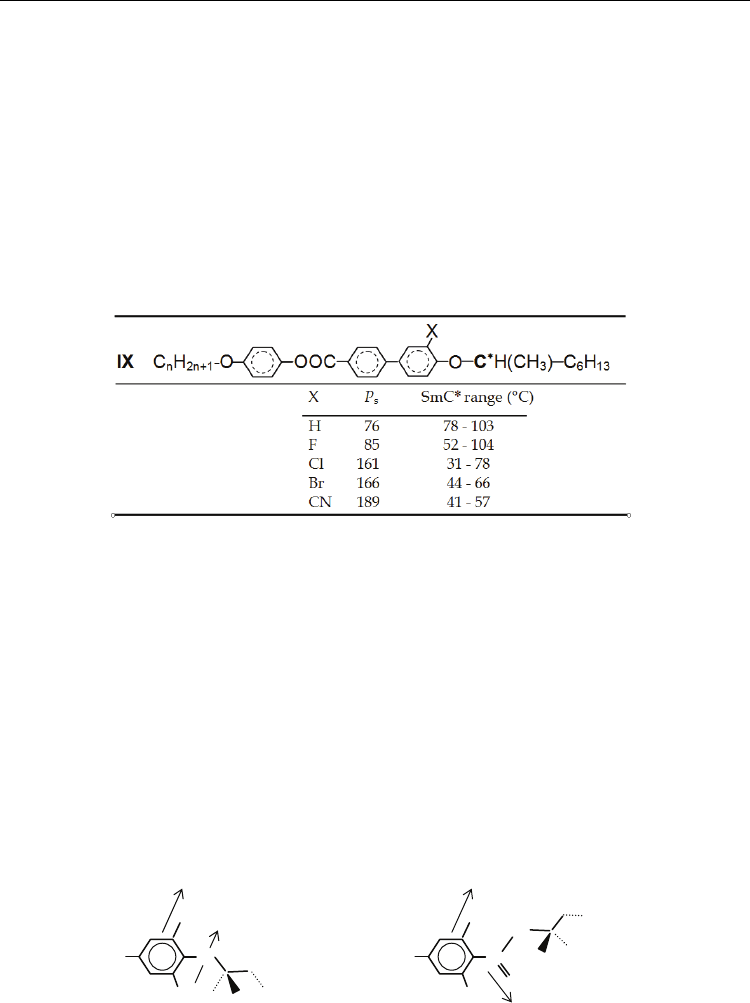
Ferroelectrics – Physical Effects
416
The additional increase of P
s
can be achieved by lateral substitution of electronegative atoms
or functional groups that behave as acceptors of electrons. The location of the substitution is
very important for the increase of P
s
. In the following, two main cases are considered
separately.
4.3.1 The effect of the lateral substitution on molecular core
This substitution is effective in the vicinity of the asymmetric carbon as well as on distant parts
of the central skeleton. It brings additional transversal dipole moment and influences steric
hindrance of both rotations of molecules about the longitudinal axis and intramolecular
rotations. Besides, the lateral substituents may influence the temperature stability of the
mesophase. Halogens (F, Cl, Br), nitril group (-C≡N), or methyl group (-CH
3
) are the mostly
used substituents. One of the possible effects of such substituents is shown in Table 5.
Table 5. Values of the spontaneous polarization P
s
(nC cm
-2
) at temperatures T
c
– 10 °C and a
temperature range of the SmC* mesophase. Influence of a substitution on the central core
near an asymmetric carbon in an ortho position to the linkage group Z (−O−), (Furukawa et
al., 1988).
With increasing volume of the substituent thermal stability of the mesophase decreases and
its temperature range becomes narrower. The substitution of chlorine appeared as the
optimal one. The significant increase of P
s
is a result of two effects: in preferential
conformation specified by MM method (Furukawa et al., 1988) the dipole moments of C-X
bond and ether group –O- are nearly parallel and thus are added up (see Fig. 4a) and
simultaneously the steric hindrance in the chiral centre between the phenyl and methyl
group restricts the rotation of the chiral group.
For another type of the central skeleton the expected increase of P
s
occurs in the following
sequence of substituents H < F < Cl < Br < CN (see Table 6). On the other hand the influence
on the thermal stability of the mesophase is lower and not so unequivocal (Furukawa et al.,
1988).
Fig. 4. Preferential conformation and mutual orientation of dipole moments p
i
and polar
groups near the chiral centre of compounds IX (a) and XVII (b).
C
X
H
CH
3
H
p
i
p
i
O
O
b)
∗
O
X
H
CH
3
H
p
i
p
i
a)
∗
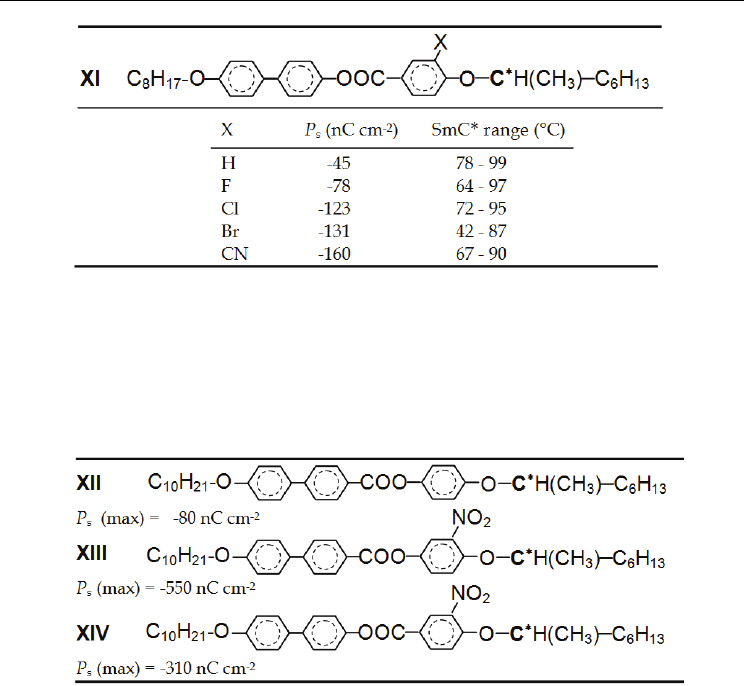
Ferroelectric Liquid Crystals with High Spontaneous Polarization
417
Table 6. Values of the P
s
at temperatures T
c
– 10 °C and a temperature range of the SmC*
mesophase. Influence of a substitution on the central core near an asymmetric carbon in an
ortho position to the linkage group Z (−O−), (Furukawa et al., 1988).
Probably the best result has been found for the substitution by the nitrogroup (–NO
2
) as is
shown for compound XIII in Table 7.
Table 7. Maximum measured values of the spontaneous polarization P
s
at compounds XII
(Inukai et al., 1986), XIII and XIV (Walba et al., 1991). Influence of a substitution on the
central core near the asymmetric carbon in an ortho position to the linkage group Z.
In Table 8 one can mention positive impact of the various lateral substitutions located on the
molecular end opposite to the asymmetric carbon (Pachomov, 1997; Hamplová et al., 2007)
on the increase of the spontaneous polarization P
s
. The methoxy substitution was the only
resulting in the decrease of P
s
, which has not been reliably explained so far.
On the other hand increase of P
s
, due to lateral substituent cannot be expected e.g. when
connecting group Z is formed by carboxyl –COO-. Then at the preferential conformations
the dipole moments of C-X and C=O bonds are antiparallel (see Fig. 2b) resulting in a
decrease of P
s
, which is shown in Table 9. Thus proximity of polar group and the chiral
centre does not assure increase of P
s
(Furukawa et al., 1988).
The value of the spontaneous polarization can be also significantly increased when the
phenyl ring in the central core is exchanged for the heterocycle (mainly nitrogenous). An
example with pyrimidine core is given in Table 10.
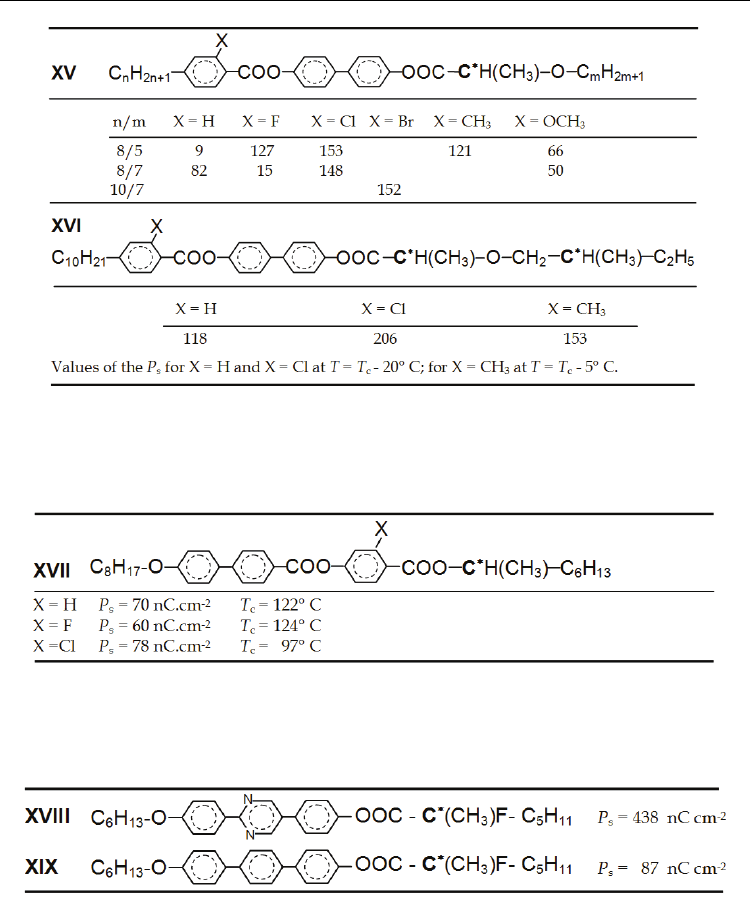
Ferroelectrics – Physical Effects
418
Table 8. Values of the P
s
(nC cm
-2
), at a substitution of the central core far from asymmetric
carbon in the meta position to the non-chiral substituent R (Pachomov, 1997). Values of the
P
s
at T = T
c
- 10° C (unless otherwise indicated).
Table 9. Values of the P
s
, at a substitution of the central core near the asymmetric carbon in
the ortho position to the linkage group Z (Furukawa et al., 1988). Values of the P
s
at T = T
c
-
10° C.
Table 10. Rise of the spontaneous polarization P
s
owing to a heterocyclic ring in the central
core of molecule (Hirai et al. 1992). Values of the P
s
are maximal measured.
4.3.2 The effect of the lateral substitution on the asymmetric carbon
Introduction of the transversal dipole moment directly to the chiral centre proved to be
efficient, as it eliminates intramolecular rotations. The impact of this type of substitution on
P
s
values is shown in Table 11. The substitution of fluorine in various configurations
